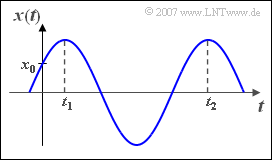Aufgaben:Aufgabe 2.3Z: Schwingungsparameter: Unterschied zwischen den Versionen
Aus LNTwww
| Zeile 68: | Zeile 68: | ||
===Musterlösung=== | ===Musterlösung=== | ||
{{ML-Kopf}} | {{ML-Kopf}} | ||
| − | '''(1)''' Es gilt $T_0 = t_2 - t_1 = 12\, \text{ms}$ und $f_0 = 1/T_0 \hspace{0.15cm} \underline{\approx 83.33\, \text{Hz}}$. | + | '''(1)''' Es gilt $T_0 = t_2 - t_1 = 12\, \text{ms}$ und $f_0 = 1/T_0 \hspace{0.15cm} \underline{\approx 83.33\, \text{Hz}}$. |
| − | |||
| + | '''(2)''' Die Verschiebung beträgt $\tau \hspace{0.1cm} \underline{= 2\, \text{ms}}$ und die Phase ist $\varphi = 2\pi \cdot \tau/T_0 = \pi/3$ entsprechend $\varphi =\hspace{0.15cm} \underline{60^{\circ}}$. | ||
| − | '''(3)''' Aus dem Wert zum Zeitpunkt $t = 0$ folgt für die Amplitude ${C}$: | + | |
| + | |||
| + | '''(3)''' Aus dem Wert zum Zeitpunkt $t = 0$ folgt für die Amplitude ${C}$: | ||
:$$x_0=x(t=0)=C\cdot\cos(-60\,^\circ)={C}/{2}=\rm 3\,V | :$$x_0=x(t=0)=C\cdot\cos(-60\,^\circ)={C}/{2}=\rm 3\,V | ||
\hspace{0.3 cm} \Rightarrow \hspace{0.3 cm}\hspace{0.15cm}\underline{\it C=\rm 6\,V}.$$ | \hspace{0.3 cm} \Rightarrow \hspace{0.3 cm}\hspace{0.15cm}\underline{\it C=\rm 6\,V}.$$ | ||
| + | |||
'''(4)''' Die dazugehörige Spektralfunktion lautet: | '''(4)''' Die dazugehörige Spektralfunktion lautet: | ||
:$$X(f)={C}/{2}\cdot{\rm e}^{-{\rm j}\varphi}\cdot\delta(f-f_0)+{C}/{2}\cdot{\rm e}^{{\rm j}\varphi}\cdot\delta(f+f_0).$$ | :$$X(f)={C}/{2}\cdot{\rm e}^{-{\rm j}\varphi}\cdot\delta(f-f_0)+{C}/{2}\cdot{\rm e}^{{\rm j}\varphi}\cdot\delta(f+f_0).$$ | ||
| − | + | *Das Gewicht der Diraclinie bei $f = f_0$ (erster Term) ist ${C}/2 \cdot {\rm e}^{–\text{j}\varphi} = 3 \,\text{V} \cdot \cos(60^\circ)- 3 \,\text{V} \cdot \sin(60^\circ)\hspace{0.05cm}\approx \underline{1.5 \,\text{V} - \text{j} \cdot 2.6 \,\text{V}}$. | |
{{ML-Fuß}} | {{ML-Fuß}} | ||
[[Category:Aufgaben zu Signaldarstellung|^2. Periodische Signale^]] | [[Category:Aufgaben zu Signaldarstellung|^2. Periodische Signale^]] | ||
Version vom 2. September 2019, 17:11 Uhr
Jede harmonische Schwingung kann auch in der Form
- $$x(t)=C\cdot\cos\bigg(2\pi \cdot \frac{t-\tau}{T_0}\bigg)$$
geschrieben werden. Die Schwingung ist somit durch drei Parameter vollständig bestimmt:
- die Amplitude $C$,
- die Periodendauer $T_0$,
- die Verschiebung $\tau$ gegenüber einem Cosinussignal.
Eine zweite Darstellungsform lautet mit der Grundfrequenz $f_0$ und der Phase $\varphi$:
- $$x(t)=C \cdot\cos(2\pi f_0t-\varphi).$$
Von einer harmonischen Schwingung ist nun bekannt, dass
- das erste Signalmaximum bei $t_1 = 2 \,\text{ms}$ auftritt,
- das zweite Signalmaximum bei $t_2 = 14 \,\text{ms}$ auftritt,
- der Wert $x_0 ={x(t = 0)} = 3 \,\text{V}$ ist.
Hinweis:
- Die Aufgabe gehört zum Kapitel Harmonische Schwingung.
Fragebogen
Musterlösung
(1) Es gilt $T_0 = t_2 - t_1 = 12\, \text{ms}$ und $f_0 = 1/T_0 \hspace{0.15cm} \underline{\approx 83.33\, \text{Hz}}$.
(2) Die Verschiebung beträgt $\tau \hspace{0.1cm} \underline{= 2\, \text{ms}}$ und die Phase ist $\varphi = 2\pi \cdot \tau/T_0 = \pi/3$ entsprechend $\varphi =\hspace{0.15cm} \underline{60^{\circ}}$.
(3) Aus dem Wert zum Zeitpunkt $t = 0$ folgt für die Amplitude ${C}$:
- $$x_0=x(t=0)=C\cdot\cos(-60\,^\circ)={C}/{2}=\rm 3\,V \hspace{0.3 cm} \Rightarrow \hspace{0.3 cm}\hspace{0.15cm}\underline{\it C=\rm 6\,V}.$$
(4) Die dazugehörige Spektralfunktion lautet:
- $$X(f)={C}/{2}\cdot{\rm e}^{-{\rm j}\varphi}\cdot\delta(f-f_0)+{C}/{2}\cdot{\rm e}^{{\rm j}\varphi}\cdot\delta(f+f_0).$$
- Das Gewicht der Diraclinie bei $f = f_0$ (erster Term) ist ${C}/2 \cdot {\rm e}^{–\text{j}\varphi} = 3 \,\text{V} \cdot \cos(60^\circ)- 3 \,\text{V} \cdot \sin(60^\circ)\hspace{0.05cm}\approx \underline{1.5 \,\text{V} - \text{j} \cdot 2.6 \,\text{V}}$.
